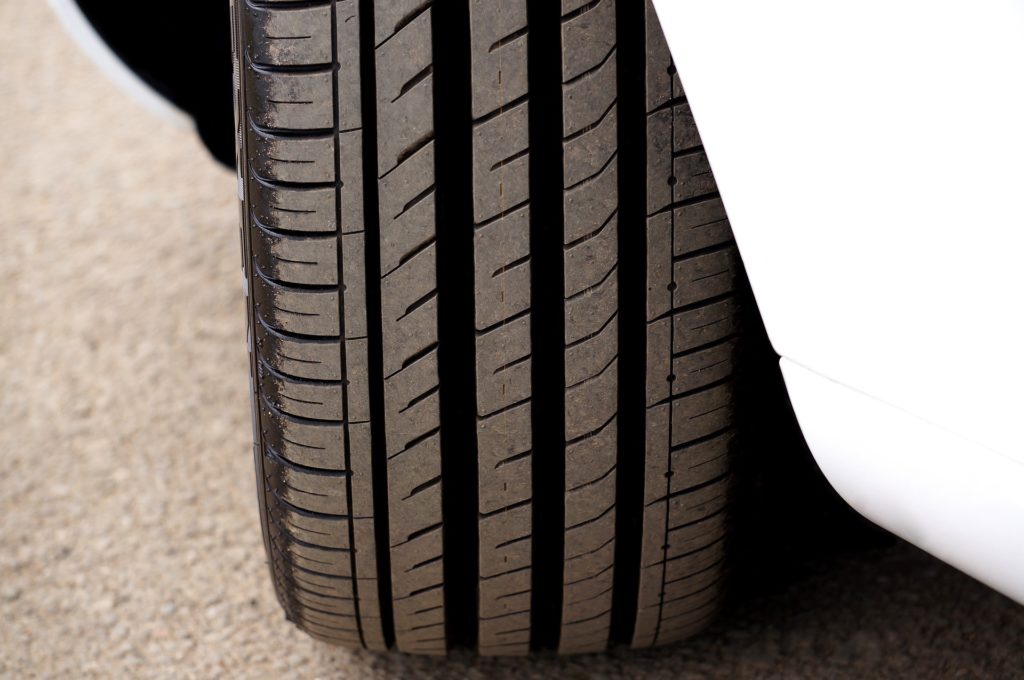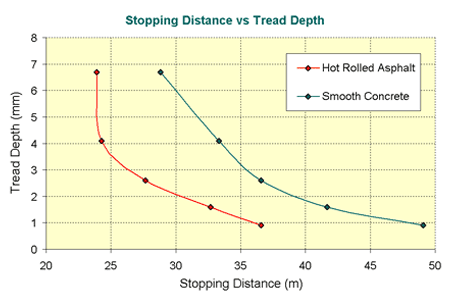‘What depth of tread do I need?’ is a question we often get asked. It turns out there’s more than one answer.
 Tread depth — the legal answer
Tread depth — the legal answer
UK Motoring law is very clear on how much tread you need on your tyres. For cars and goods vehicles (e.g. vans, not exceeding 3500kg) and for trailers and caravans not exceeding 3500kg, the legal depth is:
At least 1.6mm throughout a continuous band in the centre 3/4 of the tread and around the entire circumference.
This isn’t the only regulation relating to tyres. By law, your tyres must also be suitably inflated, have no cuts in excess of 25mm or 10% of the tyre section’s width (whichever is greater) and be ‘maintained in a fit condition.’ Here’s the full list.
If you didn’t know the legal tread depth was 1.6mm, you’re not alone. A 2017 survey found that two-thirds of UK motorists were unaware of the limit.
The maximum penalties for driving without adequate tread are severe. Currently, you can be fined up to £2,500 and receive 3 penalty points for each tyre. That means that four inadequate tyres could get you 12 points on your licence — meaning you’re disqualified from driving — and a £10,000 fine.
So…as long as you change your tyres before they’re less than 1.6mm, you’ll be fine? Not necessarily!
Tread depth — the safe driving answer
Legal tread depth and safe tread depth aren’t always the same thing. A 1.7mm tyre is legally safe, but obviously is going to perform pretty much like a borderline 1.6mm tyre or even an illegal 1.5mm.
The simple fact is that tyre performance changes continuously as it loses tread — especially its wet braking distance. As the tyre starts losing tread, its ability to disperse water gets worse and the vehicle’s stopping distance in the wet increases.
You can see this in a series of controlled tests carried out by RoSPA:

Graph shows stopping distances in wet conditions (speed not cited in article) on two different surfaces. Courtesy RoSPA.
As you can see, the deterioration depends what sort of surface you’re driving on. But what’s apparent is that below 3mm, wet stopping distances have increased significantly. By the time we get to the legal minimum tread depth of 1.6mm, the stopping distance is up by 36.8% on hot rolled asphalt and 44.6% on the concrete.
Critics could point out that this test was carried back in 2005 and tyre design has moved on since then. Fair enough, but it hasn’t moved on that much and there are plenty of other results showing broadly similar patterns. One commonly-referenced statistic is that the wet braking distance from 70mph is 44 metres greater for tyres with 1.6mm depth than 3mm. That’s about ten car lengths.
So what about tread depth and stopping in dry conditions? As tyre depth increases, you could reasonably expect these to improve. That’s because as the tyre gets smoother, there’s more surface area in contact with the road.
But here’s the thing: unless you’re going to go all Formula One and change your tyres when it starts raining, we think you have to plan for the worst case scenario.
It’s for these reasons that many motoring organisations and tyre experts recommend a minimum tread depth of 3mm.
Not all tyres are created equal
To further complicate the safe tread-depth issue, don’t forget that tyres vary massively in how they perform. As evidence, take a look at Michelin’s video comparing their own premium quality tyre with a budget brand.
It’s a pretty convincing demonstration that their tyre, with just 1.6mm of tread remaining, outperforms a brand new budget brand — at least in the wet.
Ask an expert about tyre depth
If you’re not certain about whether you need to change your tyres, we recommend you ask our expert technicians. We have a reputation for our honesty and customer service, so if we think your tyres are good for a few more thousands of miles, we’ll tell you!
BK Tyres supply and fit over 5000 types of tyre. We fit at your convenience, at home or at your place of work. For a friendly, expert and competitively-priced service, please get in touch today.
